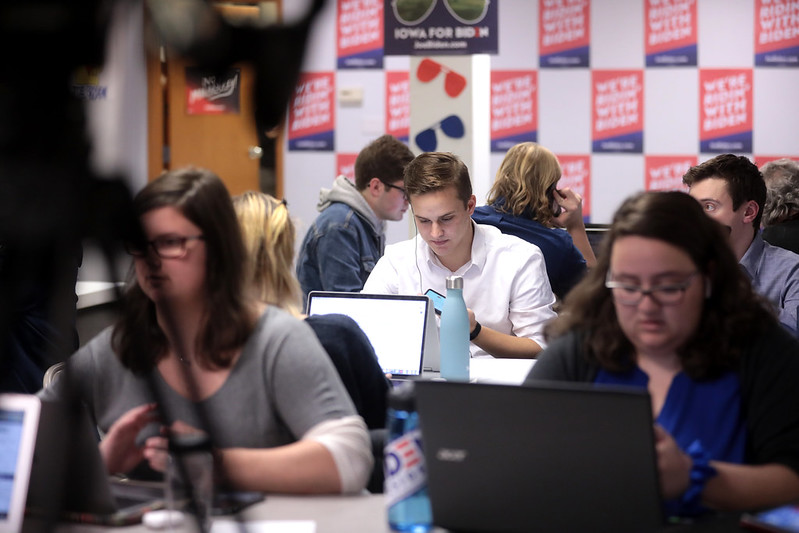What Can Polling Tell Us about the Presidential Election?
 Supporters at a phone bank at Joe Biden's presidential campaign office in Des Moines, Iowa.
“Joe Biden Supporters” by Gage Skidmore is licensed under CC BY-SA 2.0
Supporters at a phone bank at Joe Biden's presidential campaign office in Des Moines, Iowa.
“Joe Biden Supporters” by Gage Skidmore is licensed under CC BY-SA 2.0
Error in polling leading up to the 2020 presidential election was the highest in 40 years; nearly every forecast greatly underestimated President Trump’s popularity and the percentage of the national vote he would receive. While a majority of pre-election opinion polls correctly predicted President Biden’s presidency, they often overestimated the margin by which he would win. The most popular explanation for this mass inaccuracy is nonresponse bias: the possibility that Trump supporters were less willing to respond to polling inquiries than Biden supporters. However, there is no conclusive evidence for this hypothesis, nor has any alternative theory been put forward in the years since 2020. This is a result of the difficulty in predicting elections on any scale, as there is no way to know the inclinations of voters who are less politically active and therefore less likely to vote in the midterm elections. Since pollsters use data from midterm elections to help predict future presidential elections, this inactivity skews the polls significantly. These effects were evident in 2020, where swing states anticipated to vote blue, such as Florida, were ultimately won by Trump.
Without having found a solution to the errors that occurred in 2020, it’s possible that polling for Trump and Vice President Harris will yield equally inaccurate results. The most recent national polls have the two presidential candidates nearly matched in points for the national popular vote and in swing states such as Wisconsin, Georgia, and Nevada. Trump and Harris’s levels of support are within a single percentage point of each other. In a race so closely contested, the possibility that these polls are flawed makes the outcome of the election even more unclear. The presidency will likely be determined by the inclinations of independent voters—who are currently polling in Trump’s favour—and non-politically active voters. Those who don’t turn out to vote in midterms are also more likely to back Trump, meaning it’s difficult to gauge exactly how many votes the Republican party will receive in 2024. On the other hand, democratic voters are more enthusiastic about Harris as a candidate than they were about Biden. Those who previously may have been unwilling to vote for Biden in the 2024 presidential election could now show up for Harris.
Despite any efforts to foresee results, in a race this close, the chance that the winner will be predicted before election night is small. Five per cent of likely voters under 30 polled by Emerson College have yet to make up their mind about whom their vote will go to. With a significant portion of eligible voters undecided just days from the election, the winner of the popular vote is unpredictable. Even if accurate polling on the outcome of the popular vote were possible, an ‘‘inverted’’ election—in which the winner of the popular vote does not win the presidency, as we saw in 2016—is possible. This outcome would be advantageous for Trump, as Republicans have historically been favoured in inverted elections.
Just days before Election Day, polling remains inconclusive. If the faults in 2020’s polling results are any indication, the true numbers of supporters for either candidate will remain unknown until the final vote is counted on November 5.
Edited by Lily Molesky
